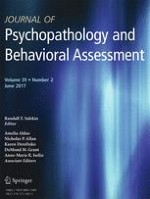14-10-2016
Construct Validity of the Acquired Capability for Suicide Scale: Factor Structure, Convergent and Discriminant Validity
Gepubliceerd in: Journal of Psychopathology and Behavioral Assessment | Uitgave 2/2017
Log in om toegang te krijgenAbstract
The Acquired Capability for Suicide Scale (ACSS) assesses one of three main constructs in the Interpersonal Theory of Suicide but evidence of its validity is limited. In two studies (Ns = 287 and 738) validity of the full 20-item ACSS and its shorter versions (ACSS-5, ACSS-8, ACSS-FAD) were examined in terms of factor structure and relation to indices of self-reported suicidal behaviour and self-harm. Confirmatory factor analysis (CFA) failed to show good fit for one-, two-, or three-factor models of the ACSS in its various versions. Exploratory factor analysis of the 20-item scale in the first study pointed instead to a five-factor structure and this was supported using CFA in the second study. In both studies all scale versions showed moderate negative correlations to fear of death and dying, indicating scale validity for the purpose of assessing fearlessness about death. In the second study, a model in which the five factors were indicators of a latent variable of Capability was found to predict a latent variable of Suicidality as indicated by suicidal behaviours, but the prediction was substantially enhanced by the addition of Item 20 to the model. This single item was also found in the first study to better predict suicidal and self-harming behaviour than the full ACSS or any of its short versions.
